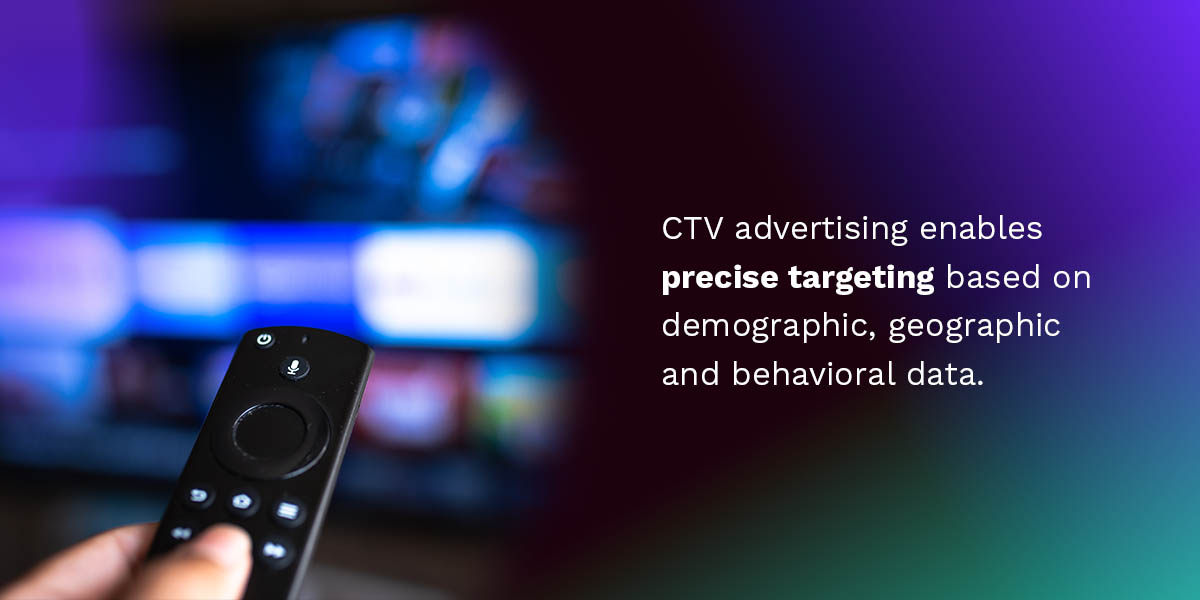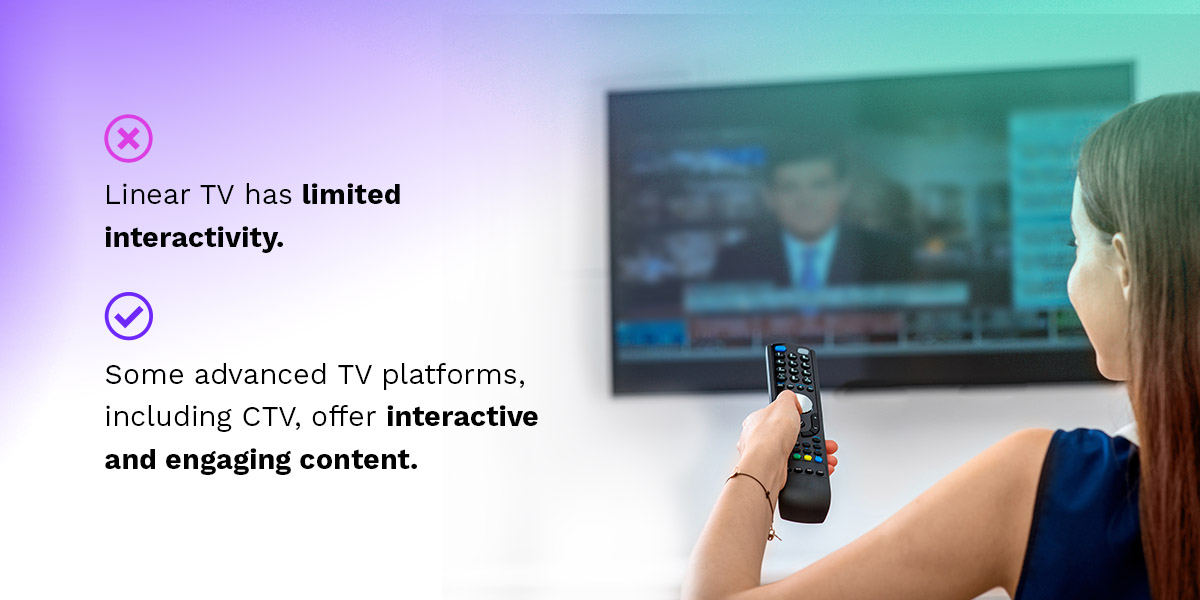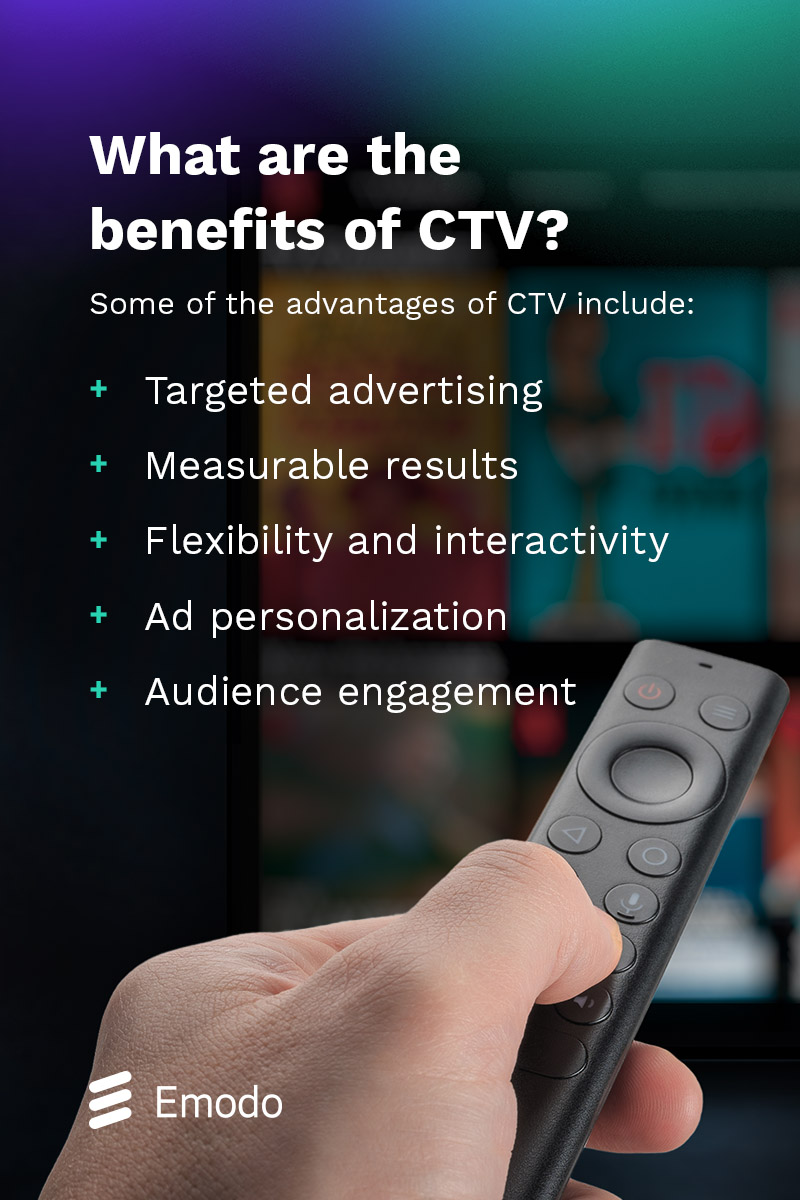Television allows advertisers and marketers to reach broad audiences through entertainment and information. However, there are different TV platforms, each providing unique advantages. Three common examples are linear, connected and advanced TV. Linear TV is the traditional version which has existed for decades. Connected TV (CTV) and advanced TV are modern innovations that allow digital streaming and data-driven targeting. Considering the numerous options available, it’s essential to understand the nuances to stay competitive in the advertising industry.
This article discusses linear TV, CTV and advanced TV in detail. You’ll learn what they are and their benefits. We’ll also examine their differences and provide tips on leveraging CTV advertising to achieve your goals. Discover which technology yields the best results for advertisers, publishers and broadcasters.
What is linear TV?
Linear TV is the traditional or broadcast television format where programs are scheduled and delivered in a fixed, predetermined sequence. Viewers can switch to other channels to view different content, which is all programmed in a timetable form. If viewers want to watch specific content, they must wait until the broadcaster airs that program. If the viewer misses the broadcast, they cannot replay the content unless they have recorded it using a digital video recorder (DVR).
The critical characteristics of linear TV are:
- Limited control: Viewers must tune in at a specific time to watch their preferred content. They cannot control when they get to watch those programs.
- Scheduled programming: TV networks allot times and dates for each program. Viewers must note those schedules to watch the programs they prefer. Alternatively, they can enjoy what the channels offer at any given time.
- Commercial breaks: Linear TV has commercial breaks, where businesses advertise their products or services. Viewers cannot pay to avoid those commercials.
- Satellite or OTA distribution: Viewers can subscribe to cable or satellite TV services to enjoy programs. Alternatively, they can watch free content with over-the-air (OTA) broadcasting.
What is linear TV advertising?
Linear TV advertising is an advertisement that appears on conventional television. Commercials or ads are delivered to viewers during scheduled programming on broadcast or cable channels. Advertisers purchase airtime slots often linked to specific programs, depending on audience interest and program relevance. Despite its limited capabilities, linear TV plays a vital role in the advertising industry.
What is CTV?
Connected television (CTV), also known as smart or internet TV, is a modern innovation that allows viewers to stream content on a television set using an internet connection. Unlike linear TV, viewers can access a wide range of entertainment options. Viewers with smart TVs or streaming devices like AppleTV, Chromecast, Roku or Amazon Fire TV sticks can use streaming platforms like Netflix and YouTube TV. Video game console owners may also stream content via those devices.
CTV is convenient and flexible, allowing viewers to enjoy content from a vast library of on-demand movies, shows and documentaries. In addition, there is an uptick in CTV app providers catering to audiences who are used to the traditional TV timetable approach, with the apps housing “live” content within a channel guide environment, allowing viewers to watch what’s playing at that given moment. The critical characteristics of CTV are:
- Internet connectivity: CTV relies on an internet connection to deliver content to viewers. Users can purchase TVs with built-in smart capabilities or use external devices like streaming sticks or game consoles.
- Flexible content options: Viewers can access content on-demand, allowing them to choose their preferred programs, regardless of time or can select from what’s playing live within streaming TV apps.
- Targeted advertising: CTV enables advertisers to target specific audiences with greater precision. Advertisers can leverage data-driven audience and targeting techniques to deliver personalized ads to viewers based on interests, behaviors and demographics.
- Ad-supported models: Most CTV publishers use ad-supported models, which enable free or discounted access to content in exchange for ad displays. Consumers understand this value exchange and it allows advertisers to optimize their ad campaigns to deliver great relevance to these audiences.
What is CTV advertising?
CTV advertising is the delivery of digital ads through CTV platforms. It takes advantage of the increasing popularity of streaming services, capitalizing on the shift from traditional television to internet-based content consumption. CTV advertising combines the best of linear and digital by allowing advertisers to reach audiences in a highly impactful TV environment with the addressability and measurement of digital.

CTV advertising offers many benefits. It enables precise targeting based on demographic, geographic and behavioral data. It also allows better measurement and tracking capabilities, enabling advertisers to strategize and develop effective campaigns.
CTV advertising is primarily delivered within the video stream and can appear before, during or after the selected content is played. In addition, there is a rise in interactive ads that incorporate QR codes and overlays and some CTV platforms also have display ads within their user interfaces. Advertisers can run their ads on specific streaming services or through programmatic advertising platforms that facilitate the buying and selling of ad inventory across multiple publishers.
What is advanced TV?
Advanced television is an umbrella term for the various kinds of non-traditional television. Unlike conventional TV, where the networks air programs on specific channels according to designated time slots, advanced TV allows viewers to choose whatever they want to watch whenever they want. One of the primary differences between linear and advanced TV is how ads are delivered. Advanced TV enables more accurate ad targeting than conventional television.
Advanced TV encompasses broad capabilities, including:
- Connected TV: CTV is an internet-connected device that enables viewers to stream content, such as smart TVs, streaming devices and game consoles.
- Over-the-top TV (OTT): OTT is the delivery of content, including TV shows and movies, over the internet. The difference between CTV and OTT is that OTT is the content delivery mechanism, while CTV is the device viewers use to watch the content. Besides the television set, OTT allows viewers to access content on smartphones, tablets, PCs, and laptops.
- Converged TV: This technology encompasses linear TV, CTV and digital video. In other words, it blends satellite, cable and streaming services to provide access to linear TV channels and on-demand content.
- Addressable TV: This form of TV advertising enables advertisers to show different ads to different individuals in a household. It leverages data analytics and digital technology to segment audiences.
- TV everywhere: This subscription business model allows cable subscribers to watch live and on-demand content. Users create accounts that are authenticated before granting access. After that, they can watch the content from their networks through internet-based services.
What is advanced TV advertising?
Advanced TV advertising uses data-driven approaches to deliver targeted and personalized ads to viewers across TV platforms. It combines traditional TV and digital ad capabilities, enabling precise targeting, measurement and interactivity. Advanced TV ads leverage innovations such as addressable TV and programmatic ads to deliver flexible solutions to businesses of all sizes.
What are the differences between linear TV, CTV and advanced TV?
Below are the main distinctions between linear, CTV and advanced TV:
1. Content delivery
The internet drives content delivery on advanced TV platforms, including CTV. Viewers access the content through streaming services, which are mostly available on demand. Users can decide what to watch and when to watch it. The content on linear TV is delivered via conventional satellite or cable connections. Programs are allotted time slots, giving viewers limited control over when they can watch their preferred content.
2. Interactivity and engagement

Some advanced TV platforms, including CTV, offer interactive and engaging content. For example, viewers can participate in polls or select ads for more information. Conversely, linear TV has limited interactivity. Viewers only get what they see, usually without the option to engage with the content or ads.
3. Targeting capabilities
Advanced TV capabilities like CTV provide highly granular targeting solutions. They use data analytics to reach specific audiences based on interests, demographics, location and viewer habits. With such high precision levels, brands can optimize ad campaigns to increase their return on investments (ROI). Linear TV ads can reach a large audience, although not as targeted. It adopts a broad demographic approach with limited precision and personalization.
4. Reach and scale
Advanced TV and CTV are growing exponentially, attracting a wider audience over the years. The technology is expected to grow consistently, surpassing traditional TV in popularity. While linear TV’s reach is dropping gradually in favor of advanced TV, traditional television remains predominant among older viewers, providing advertisement opportunities for brands targeting that demographic.
What are the benefits of linear TV?
Linear TV has many benefits, including:
- Wide reach: Traditional TV is still relevant because of its broad audience reach. This allows advertisers to connect with many viewers in a single ad placement. Linear TV ads are ideal for targeting older age groups who may be less likely to adopt streaming platforms.
- Brand awareness: Traditional TV has been a powerful medium for building brand awareness for years. The combination of sight, sound and motion in TV ads can create memorable and impactful brand experiences. It allows advertisers to create captivating ads, some of which audiences still remember decades later.
- Trust and credibility: Most broadcasting networks and cable channels have an established reputation among their viewers, creating a sense of confidence and credibility. Associating a brand with trusted channels can enhance the brand’s image.
- Simplicity: Linear TV ads typically follow a straightforward process, making it easier for advertisers to plan and execute their campaigns. Advertisers can negotiate ad placement to secure time slots or advertise products or services during popular programs.
- Event-based ads: Linear TV is best suited for event-based advertising, such as sports events and live performances. Advertisers can leverage the shared experiences of live TV to engage audiences and generate excitement around their brand.
- Local targeting: Linear TV allows advertisers to target local markets, which can benefit local or regional businesses.
What are the benefits of CTV?
Some of the advantages of CTV include:

- Targeted advertising: CTV enables precise audience targeting based on factors like interests, demographics and past purchased behavior. Advertisers can deliver relevant ads to specific audience segments, increasing ad efficiency.
- Measurable results: CTV has ad measurement and tracking capabilities, enabling advertisers to ascertain the success of their campaigns. Advertisers can access metrics such as views, impressions, interactions and conversions to make data-driven optimizations.
- Flexibility and interactivity: CTV ads are flexible and interactive. Advertisers can leverage interactive elements such as calls-to-action and clickable overlays to allow viewers to engage directly with the ad content.
- Ad personalization: Advertisers can personalize ad experiences based on viewer data to help achieve campaign goals more efficiently.
- Audience engagement: Streaming on-demand services allows viewers to choose their preferred content, keeping them engaged for extended periods. This heightened engagement increases the chances of viewers paying attention to ads and responding positively to the advertising messages.
What are the benefits of advanced TV?
Advanced TV has many benefits, including:
- Data-driven insights: Advanced TV advertising provides advertisers with rich data-driven insights into ad campaigns. Advertisers can leverage this information to make informed decisions and improve campaign performance.
- Cross-channel integration: Advertisers connect their TV advertising efforts with digital marketing strategies, enabling them to synchronize their messaging across multiple platforms.
- Programmatic capabilities: Advertising on advanced TV uses programmatic advertising to automate the buying and selling of ad inventory in real time.
- Enhanced creative opportunities: Advanced TV advertising creates new opportunities for advertisers, including interactive capabilities. These solutions can improve viewer engagement and ensure better brand interactions.
- Addressable advertising: Advanced TV advertising enables addressable advertising, where advertisers deliver personalized ads to different individuals in a household with the same broadcast or streaming environment.
Strategies for leveraging CTV advertising
CTV has gained momentum in the media and advertising industry, offering practical solutions for brands worldwide. Yet, it’s essential to learn how to implement them effectively to increase your ROI. Below are four helpful tips:
- Define your target audience: Clearly define your target audience at the beginning of each ad campaign. Knowing your ideal viewers’ preferences can help you create relevant ads and make the best use of the available streaming platforms.
- Test and learn: CTV advertising is a dynamic and rapidly evolving space. Therefore, it’s crucial to continuously test different targeting parameters, creative variations and strategies to determine which works best for your brand and audience. You can learn from the insights you gain and apply them to optimize future campaigns.
- Stay updated: Stay informed about the latest technologies, best practices and trends in CTV advertising, including emerging platforms, ad formats and targeting capabilities. This helps you capitalize on the most effective solutions.
- Partner with an experienced provider: Consult professional CTV advertising agencies for guidance on navigating the intricacies of CTV ad buying, targeting and optimization. A reliable provider can eliminate time and money waste, especially during the trial-and-error phase.
Emodo: Your Trusted CTV Solutions Provider
As consumers move from traditional television to advanced TV technologies like CTV, advertisers must understand how these platforms work and how to harness their full potential. One practical approach is partnering with professionals who have the resources to enable you to reach your goals.
Emodo is shifting with the changes in the digital age, providing clients with immersive and creative advertising solutions. Emodo aims to reimagine CTV ads and build memorable connections with consumers. To learn more about how we can help you optimize your CTV advertising efforts, contact us now!
MORE LIKE THIS



